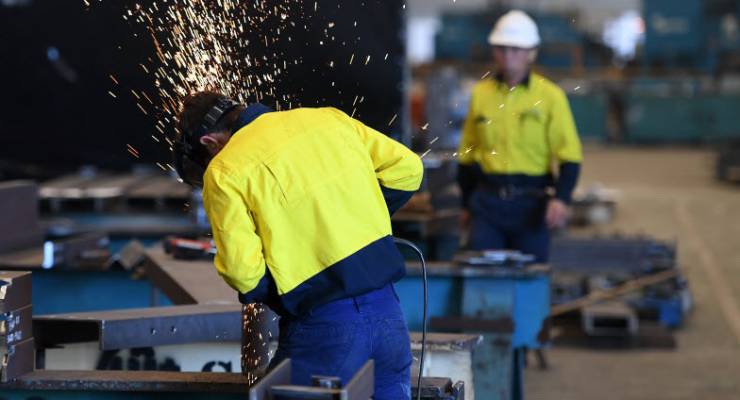
Despite a softening economy, stagnant wages and rising unemployment this year, there’s been one super-powered economic indicator in 2019 for Australia — our trade surplus. Yesterday’s June trade data showed a 2018-19 surplus of $50.3 billion, more than four times the $11.67 billion surplus in 2017-18, powered by a 13% rise in the value of exports to a record $474.3 billion. The June monthly surplus of $8.04 billion easily topped the previous record in May of $6.17 billion.
As much as we’d love to give ourselves a pat on the back — especially those of us old enough to remember the 1980s when we were excoriated for our persistent trade deficits — it was mainly thanks to the surge in iron ore prices since last November. Vale’s January mine dam disaster in Brazil saw Australian iron ore prices jump 72%, from around US$72 a tonne to US$125 a tonne on July 2. Overall, the Reserve Bank’s monthly Commodity Price Index leapt 21% in Australian dollar terms in the year to July, with the July reading of 131.5 the highest since June 2011.
We should enjoy it while it lasts, because since then iron ore prices have slumped 23% to around US$97 a tonne ton yesterday, meaning iron ore is now in a bear market — a 20%-plus fall from its most recent high. This month is likely to be the peak of the surplus as iron ore prices fall back to earth, pulled not just by Vale eventually bringing Brazilian iron ore production back online but Donald Trump’s trade war dampening Chinese demand.
Trump’s escalation of the trade war with China, and China’s response, knocked stock markets lower, including wiping $98 billion in value from the ASX, and triggering a buying rush for government bonds across the major world economies. This included Australia, where the yield on 10 year bonds briefly fell under 1% yesterday (which is under the Reserve Bank’s cash rate of 1%) before ending at a new record close of 1.04%. That’s handy, because the falling iron ore price might yet crimp the government’s push back to budget surplus.
The share market doesn’t just have Trump to deal with: the construction sector is coming under pressure with the collapse of two big developers in the past two months — Steller in Melbourne and Ralan on the Gold Coast and in Sydney — while the Sydney market is beset with very real concerns that new apartment constructions are unsafe.
This morning, the Performance of Construction Index from the Australian Industry Group and the Housing Industry Association showed a sharp 3.9 point drop to 39.1 points, showing that “the construction industry on aggregate declined more sharply in July, and at the steepest rate in six years” which “largely reflected a steep and accelerated decline in new orders and employment”. The main culprit was apartment construction, which contracted for the 16th straight month.
Until now the contraction in construction and manufacturing — which is in deep trouble — has been at odds with our surging services sector. But AIG’s services index also recorded a steep fall earlier this week, back into contractionary territory. These indices are volatile, but the overall trend points to an economy that’s not just tepid but perhaps teetering on the edge of something worse.
It confirms the Reserve Bank — contrary to The Australian Financial Review and John “interest rates are always higher under a Liberal government” Howard last night on the ABC — was right to cut rates twice. And despite yesterday’s decision to wait and see on rates for now, the RBA is on track to cut again in coming months, and perhaps a couple of times, unless there’s a marked turnaround in the economy.









I’m buggered if I know why anyone ever listens to anything Howard has to say about the economy. As Treasurer in the Fraser Govt, he oversaw double digit inflation, double digit unemployment and double digit interest rates – a rare trifucta.
As PM, he flogged the money machine called Telstra, gave us huge structural imbalances based on the temporary mining bonanza, underspent on infrastructure, and left a whole lot of timebombs, as warned by Costello at the time, for ensuing administrations.
He was a suburban solicitor and would not be fit to sit in the same room as any half-numerate economist, yet the media keep reporting his economic ignorance as though he has a shred of credibility.
Thanks, DF, you summarised my reaction nicely. Why is ‘our’ (supposedly ‘left-wing’) ABC wasting my money interviewing this fossil? Like his mentor, Menzies, the only thing he was good for was winning elections.
Oz has a way to go as the US is decoupling it’s economy from China and the US Secretary of State on his recent visit has suggested Oz does likewise which raises the interesting point, when does a US suggestion become an instruction. With Oz reaching agreements with the US Defence Secretary and the Secretary General of NATO then China will also recalibrate its Commodity dependencies to meet its own strategic requirements. All in all I can see the Oz economy entering uncharted waters for this next decade of adjustment. The above adjustments are quite independent of any required as the impact of Climate Change becomes ever more apparent. Even now in NSW there are a number of Country Towns relying on bottled water being freighted in, for how long is that going to prove sustainable ?